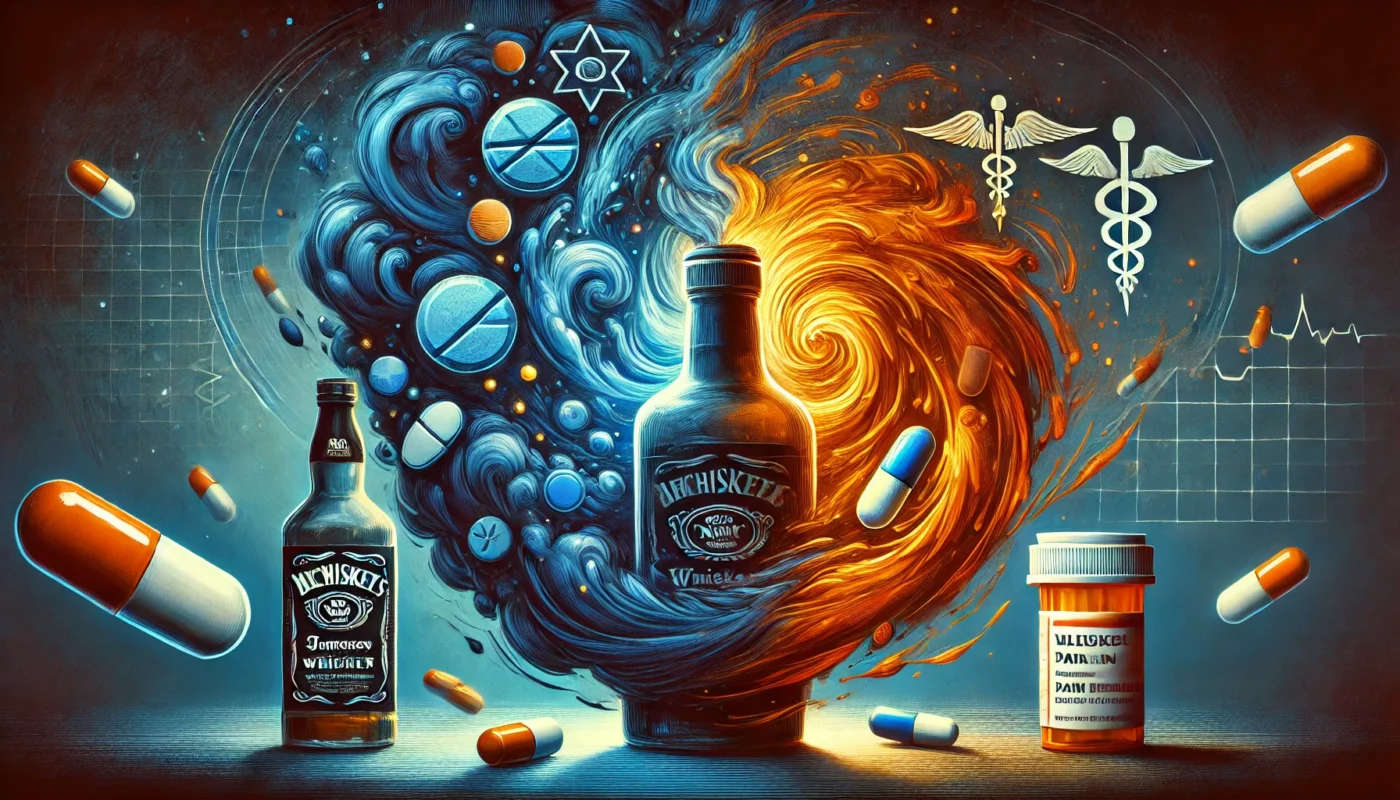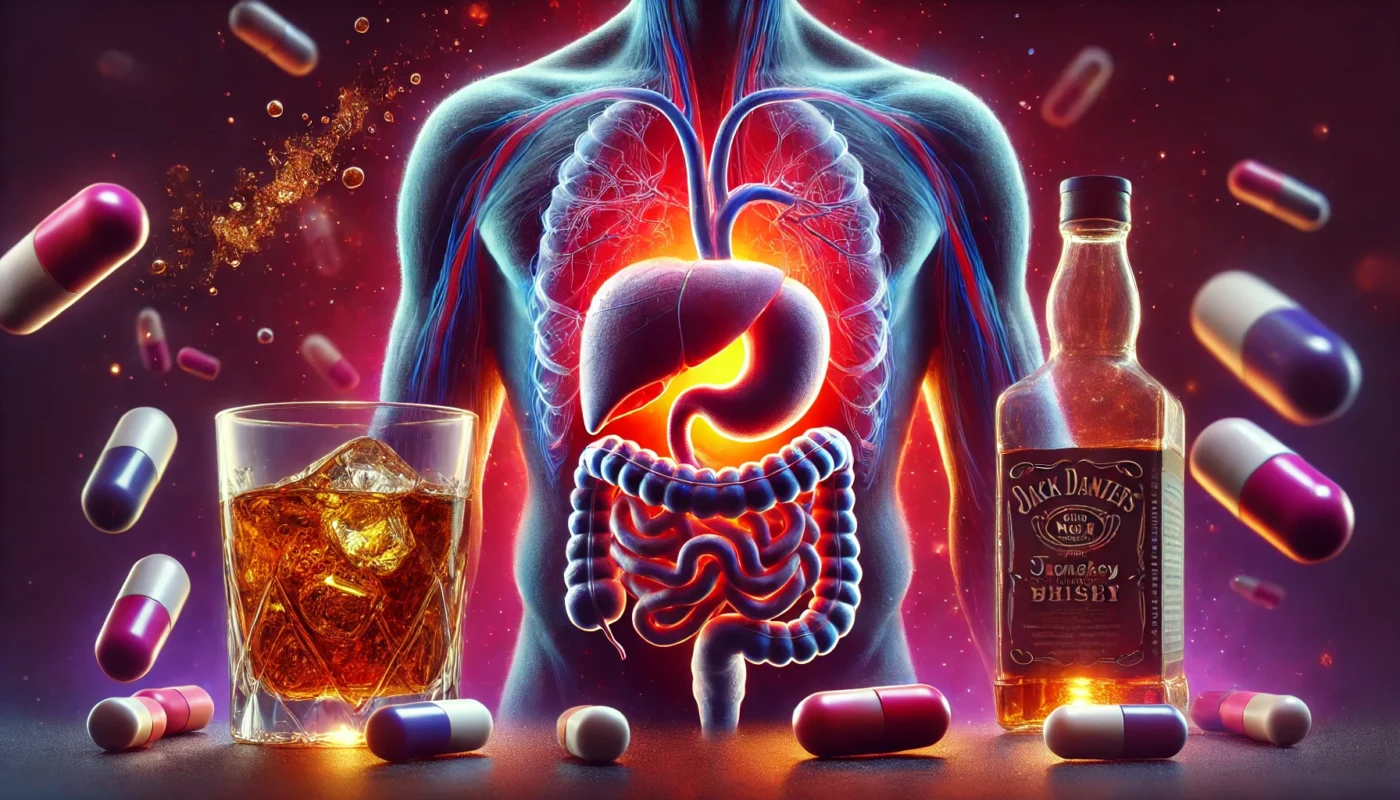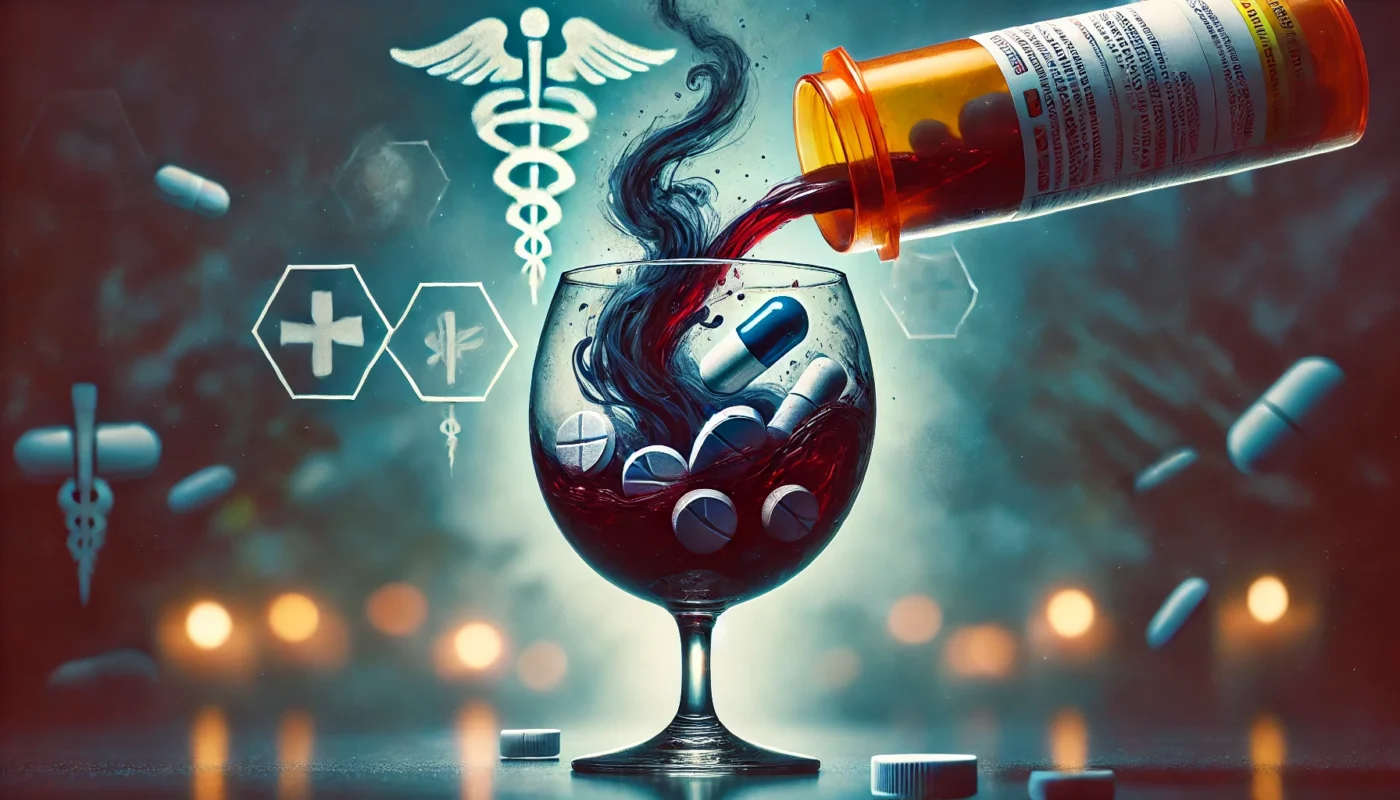Understanding why alcohol and pain pills don’t mix requires delving into the science of how these substances interact with our bodies. Alcohol, a central nervous system depressant, affects the brain by slowing down its functions. Pain pills, particularly opioids and certain over-the-counter medications like acetaminophen and ibuprofen, also have profound effects on the central nervous system and other bodily functions.
You may also like: Understanding Long-Term Pain Relief Options
How Alcohol Affects Pain Medications
When alcohol is consumed with pain medications, it can enhance the effects of the drugs, leading to increased drowsiness, dizziness, and even respiratory distress. This potentiation is especially dangerous with opioids, as it can lead to life-threatening respiratory depression. Understanding the pharmacokinetics of these interactions is crucial in recognizing the potential for compounded effects.
Moreover, alcohol can alter the metabolism of medications in the liver. For example, with acetaminophen, alcohol can increase the risk of liver damage because both substances rely on the liver for metabolism. Chronic alcohol consumption may induce liver enzymes, potentially altering the breakdown of these pain medications and leading to toxic levels in the body. This enzyme induction can lead to increased clearance of some drugs while accumulating others, posing varied risks depending on the medication.

The Role of the Central Nervous System
Both alcohol and pain medications, particularly opioids, exert their effects on the central nervous system (CNS). Alcohol depresses CNS activity, leading to sedation, impaired motor function, and decreased cognitive abilities. When combined with pain medications that also target the CNS, the effects can be significantly magnified. This dual impact on the CNS can result in severe sedation, reduced respiratory function, and impaired cognitive processing, which are dangerous and potentially fatal.
The interaction between alcohol and the CNS is further complicated by the variability in individual tolerance levels. Some individuals may experience heightened sensitivity to the depressant effects of alcohol and pain medications, increasing their risk for severe side effects. Understanding individual variability in response to these substances is essential for safe consumption.
Impact on Organ Systems
Beyond the central nervous system, alcohol and pain medications can have profound effects on other organ systems. The liver, as mentioned, is a primary site of metabolism for both substances, and its function can be compromised by their combined use. Additionally, the gastrointestinal system can also be adversely affected, with increased risk for bleeding and ulcers due to the irritating effects of alcohol and certain pain medications.
The renal system may also be impacted by the combination of alcohol and pain medications. Both alcohol and certain pain medications can lead to dehydration and increased renal workload, potentially resulting in impaired kidney function. This is particularly concerning for individuals with pre-existing renal conditions, who may experience exacerbated symptoms or rapid deterioration of renal health.
Potential Side Effects and Complications
The side effects of combining alcohol with pain meds can range from mild to severe. Common side effects include nausea, vomiting, and gastrointestinal bleeding. More severe complications might include liver damage, kidney dysfunction, and increased risk of overdose.
Gastrointestinal Complications
The gastrointestinal system is often one of the first to be affected by the combination of alcohol and pain medications. Alcohol can irritate the lining of the stomach and intestines, increasing the risk of gastrointestinal bleeding. When combined with NSAIDs like ibuprofen, which also increase bleeding risk, the potential for severe gastrointestinal complications rises significantly.
Individuals taking medications that affect the gastrointestinal tract should be particularly cautious about alcohol consumption. Symptoms such as stomach pain, heartburn, or indigestion may be early warning signs of more severe complications. Recognizing these symptoms early and adjusting alcohol or medication use accordingly can help mitigate risks.
Respiratory Risks
One of the most serious risks of combining alcohol with pain medications, particularly opioids, is respiratory depression. Alcohol and opioids both depress the central nervous system, leading to slowed breathing and reduced oxygen intake. In extreme cases, this can result in hypoxia, brain damage, or death.
Those with pre-existing respiratory conditions, such as asthma or COPD, are at heightened risk for severe respiratory complications. Monitoring respiratory function and being aware of symptoms such as shallow breathing, confusion, or bluish skin can help prevent potentially fatal outcomes.

Hepatic and Renal Concerns
The liver and kidneys play crucial roles in the metabolism and elimination of both alcohol and pain medications. Chronic alcohol consumption can lead to liver damage, and when combined with medications metabolized by the liver, such as acetaminophen, the risk of hepatic injury increases significantly.
Similarly, the kidneys are responsible for filtering waste products from the blood. Alcohol and certain pain medications can impair renal function, leading to toxin buildup and potential kidney damage. Individuals with pre-existing liver or kidney conditions should be particularly cautious when considering alcohol consumption with pain medications.
Why People Mix Alcohol and Pain Pills
Despite the risks, people often mix these substances for various reasons. Some might do so inadvertently, unaware of the interactions. Others might seek enhanced effects, whether for pain relief or recreational purposes. However, understanding the potential consequences is crucial for making informed decisions about their use.
The Influence of Social and Cultural Factors
Social settings often encourage alcohol consumption, and individuals taking pain medication might feel pressured to partake. Cultural norms around drinking can sometimes overshadow the importance of medication guidelines, leading to risky behaviors. Social gatherings can create environments where alcohol is readily available and consumed, often without consideration of its interactions with medications.
Peer pressure can also play a significant role in the decision to mix alcohol with pain medications. Individuals may feel compelled to conform to social drinking norms, even when aware of the potential risks. Understanding the social dynamics at play can help individuals navigate these situations more safely.
Misconceptions and Lack of Awareness
There is a general lack of awareness about the specific interactions between alcohol and pain medications. Many individuals assume that over-the-counter painkillers are safe to combine with alcohol, not realizing the potential for serious harm. This misconception is often fueled by inadequate labeling or insufficient information provided by healthcare providers.
Education plays a critical role in preventing harmful interactions. Increasing awareness of the risks associated with combining alcohol and pain medications can empower individuals to make safer choices. Healthcare providers can play a pivotal role in disseminating this information through patient education and clear communication of risks.
Intentional Mixing for Enhanced Effects
Some individuals intentionally mix alcohol and pain medications to enhance the effects of either substance. This practice is particularly prevalent among those seeking recreational highs or stronger pain relief. However, the perceived benefits are often overshadowed by the significant risks of overdose, addiction, and severe health complications.
Understanding the motivations behind intentional mixing can help healthcare providers offer targeted interventions and support. Providing resources for addiction treatment and counseling can be effective strategies for addressing this issue and reducing the associated health risks.
Strategies for Safe Use of Pain Medications
Given the risks, it’s important to approach the use of alcohol and pain medications with caution. Here are some strategies to help you manage these substances safely:
Consult with Healthcare Providers
Before mixing any substance with alcohol, consulting with a healthcare provider is essential. They can provide personalized advice based on your specific medications and health conditions. Always discuss any potential interactions and follow the prescribed dosages. Regular check-ins with healthcare providers can help monitor any adverse effects and adjust treatments as necessary.
Healthcare providers can also offer guidance on alternative pain management strategies, reducing the need for medications that interact with alcohol. They can evaluate the necessity of each medication and explore options with fewer interactions, thereby minimizing risks.
Understanding Labels and Warnings
Pay attention to medication labels and warnings. Many pain medications come with specific instructions about alcohol use. Understanding these warnings can prevent accidental harm. It’s important to read labels thoroughly and seek clarification from pharmacists or healthcare providers when needed.
Labels often provide crucial information about potential side effects, interactions, and contraindications. Familiarizing oneself with this information can facilitate informed decision-making and reduce the likelihood of harmful interactions. Keeping medication guides handy and regularly reviewing them can reinforce safe practices.

Alternative Pain Management Techniques
Exploring alternative pain management strategies can reduce reliance on medications. Techniques such as physical therapy, acupuncture, mindfulness, and herbal remedies offer holistic approaches to pain relief without the risks associated with medication and alcohol interactions. These methods can be particularly beneficial for individuals with chronic pain conditions.
Incorporating lifestyle changes, such as regular exercise and a balanced diet, can also contribute to pain management and overall well-being. These strategies promote physical and mental health, potentially reducing the need for pain medications. Healthcare providers can offer guidance on integrating these techniques into daily routines.
Practical Tips for Health Enthusiasts
For those engaged in fitness and wellness pursuits, understanding the role of alcohol and pain medications in your regimen is key to maintaining optimal health:
- Moderation is Key: If you choose to consume alcohol, do so in moderation and be mindful of the timing relative to medication intake. Keeping track of alcohol consumption and timing it appropriately with medication schedules can prevent harmful interactions.
- Plan Ahead: If you know you’ll be in a social setting where alcohol is present, plan your medication schedule accordingly to avoid interactions. This may involve adjusting the timing of medication doses or choosing non-alcoholic alternatives during social gatherings.
- Stay Informed: Keep up with the latest research and guidelines on alcohol and medication interactions to make informed decisions. Subscribing to health newsletters or consulting reputable sources can provide valuable updates and insights.
Conclusion
The intersection of alcohol and pain pills is a critical consideration for anyone invested in their health and wellness journey. While the risks are significant, understanding and respect for these potential interactions empower you to make safer, informed choices. By being proactive and informed, you can safeguard your health while still enjoying life’s moments responsibly. Through education, awareness, and consultation with healthcare professionals, you can navigate these challenges and prioritize your well-being effectively.
Further Reading:
Alcohol-Medication Interactions: Potentially Dangerous Mixes
alcohol, pain medications, opioids, central nervous system, liver health, kidney function, gastrointestinal risks, respiratory depression, safe medication use, health awareness, addiction prevention, pain management, healthcare consultation, wellness tips, substance interactions
Important Note: The information contained in this article is for general informational purposes only, and should not be construed as health or medical advice, nor is it intended to diagnose, prevent, treat, or cure any disease or health condition. Before embarking on any diet, fitness regimen, or program of nutritional supplementation, it is advisable to consult your healthcare professional in order to determine its safety and probable efficacy in terms of your individual state of health.
Regarding Nutritional Supplements Or Other Non-Prescription Health Products: If any nutritional supplements or other non-prescription health products are mentioned in the foregoing article, any claims or statements made about them have not been evaluated by the U.S. Food and Drug Administration, and such nutritional supplements or other health products are not intended to diagnose, treat, cure, or prevent any disease.

